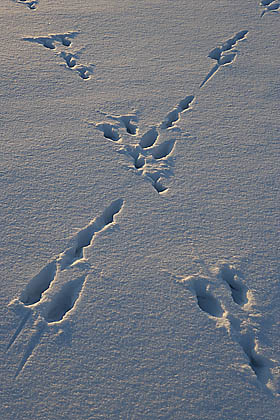The winter of the brown hare
Photo: Arne Ader
Translation: Liis
Crossroads. Hare tracks in snow
| Brown hare, European hare | Halljänes |
With the thick snow cover the winter diet of the brown hare is shoots of trees, buds and bark. Aspen, willow, rowan, birches at forest edges – but damage is done in orchards. The snow carries a hare, getting over fences from the high snowdrifts is the easiest thing in the world, and they start moving about in shelter of the evening dusk.
You look and ponder: why is it that mostly just a few younger fruit tree have the bark on their trunks so thoroughly chewed, with serious damage to the tree? All animals need water for their digestion and a fruit tree that stands above a water vein has in spite of the winter a much better water supply and so is much juicier – that is one possible explanation, but the doings of hares are often unpredictable.
Brown hares eat their food twice because they have a simply constructed stomach and in order to extract the nutrients fully they have become in part coprophags. The first loose stools are eaten again and after the second round of digestion the familiar hare droppings are excreted.
Our brown hares have no shortage of enemies, among predators as well as birds of prey that can cope with adult hares weighing three to seven kilos. But hares are fast and skilled and know their territory and its shelters inside and out. Because of this the average life length of the prodigiously reproducing brown hares isn’t particularly short after all, estimated to be 6 years. The population is more than 40 000 pairs.
Depending on the winter weather the mating period of brown hares begins some time in the second half of February. This winter’s most severe frosts are promised for next week; we will see how things work out.









